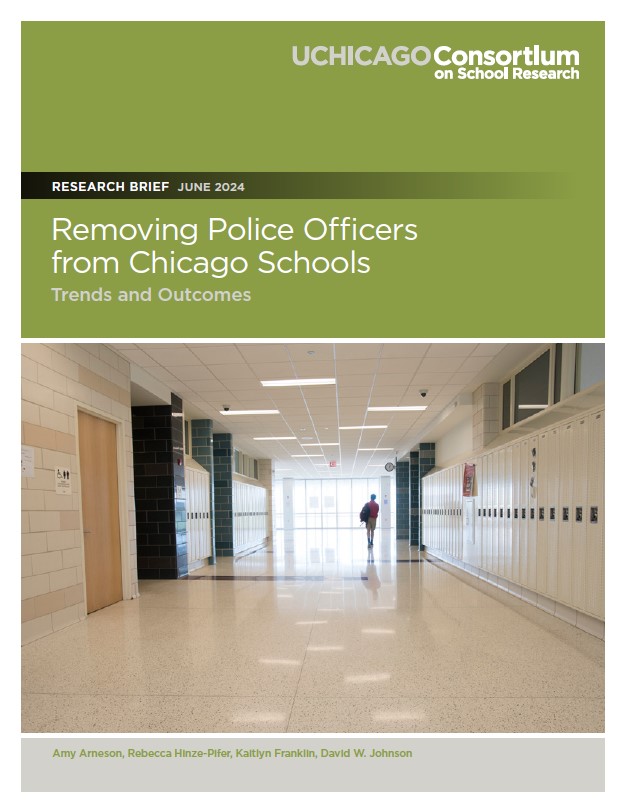1. What were the characteristics of schools that retained, partially removed, or fully removed SROs?
- What were the characteristics of students in schools that made different decisions about SROs?
2. When Chicago Public Schools high schools removed one or both SROs, how did school climate & discipline outcomes change?
- School climate: Student and teacher perceptions of physical safety, student perceptions of relationships with teachers
- Discipline outcomes: All behavioral infractions, high-level behavioral infractions, suspensions, & police notifications
Overview
National context: Schools across the United States have long grappled with the role and impact of school-based police officers, often referred to as school resource officers (SROs). Proponents for school-based policing believe that SROs contribute to school safety by preventing or addressing crime and violence in schools. Opponents of SROs in schools argue that the presence of SROs criminalizes students and increases the likelihood of school-based arrest, particularly for students of color. Policies around SROs vary in districts across the country.
Chicago context: In the wake of George Floyd’s murder in 2020, the Chicago Board of Education (CBOE) asked the district to develop a plan to phase-out the SRO program, which assigned two SROs to most Chicago Public Schools (CPS) high schools. In February 2024, the CBOE voted to remove all remaining SROs from schools starting in 2024–25. In May 2024, CPS proposed a Whole School Safety Policy that did not include SROs and focused on supports for physical safety, emotional safety, and relational trust in schools.
The research: This brief examines what happened when Chicago Public Schools (CPS) began the process of removing School Resource Officers (SROs) from its high schools during the 2020–21 school year.
These findings can inform conversations in Chicago, and across the country, about SROs and whole school safety practices and policies—while recognizing that questions about the presence of police and the experience of safety in schools are complex and reflect differences in lived experiences and perspectives across policymakers, practitioners, young people, families, and communities.
The findings are part of a larger, ongoing study by researchers from the UChicago Consortium; University of Illinois, Urbana-Champaign; and Lurie Children’s Hospital’s Center for Childhood Resilience.
Key Findings
Schools removed SROs without detrimental changes in student disciplinary outcomes or perceptions of school climate.
- SRO removal was significantly related to having fewer high-level discipline infractions.
- While high-level discipline infractions rose districtwide from 2018–19 to 2022–23, schools that had fully removed SROs did not have similar increases in high-level discipline infractions; their rates remained relatively flat.
- SRO removal was not related to changes over time in:
- Student 5Essentials Survey reports of perception of physical safety or student-teacher trust.
- Teacher survey reports of perception of physical safety (supplemental items on 5Essentials Survey).
Where SROs were, and were not, removed differed by schools’ student body composition.
- Schools that retained both SROs in 2022–23 (vs. schools that removed both SROs) were more likely to:
- Serve predominantly Black students.
- Black students became more than twice as likely as other students to have an SRO in their school.
- Be smaller and have higher suspension rates.
- Serve predominantly Black students.
- Although students in all groups were much less likely to have an SRO in their school in 2022–23 compared to 2018–19, students who were eligible for free or reduced-price lunch, not English Learners, or in special education were more likely than their peers to be in schools that retained one or both SROs.








